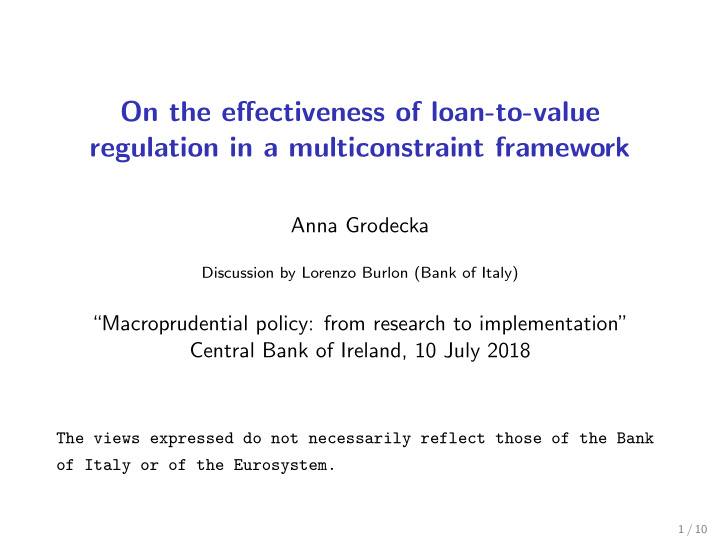



On the effectiveness of loan-to-value regulation in a multiconstraint framework Anna Grodecka Discussion by Lorenzo Burlon (Bank of Italy) “Macroprudential policy: from research to implementation” Central Bank of Ireland, 10 July 2018 The views expressed do not necessarily reflect those of the Bank of Italy or of the Eurosystem. 1 / 10
THE PAPER IN A NUTSHELL ◮ Provides micro-data evidence from Sweden of: ◮ slackness (or lack thereof) of LTV and DSTI constraints, ◮ partition of constrained borrowers between classes: LTV-only, DSTI-only, LTV & DSTI. ◮ Crucial claim: with DSTI constraints, lower LTV limit may not imply lower debt-to-GDP ratio (and may even increase house prices). ◮ Model-based assessment: ◮ simple and full model with long-term debt (calibrated to Sweden); ◮ steady-state comparison with different levels of constraints; ◮ deterministic simulations with occasionally binding constraints. 2 / 10
THE PAPER IN A NUTSHELL ◮ Interesting topic. ◮ Intriguing micro evidence. ◮ A step in the right direction in terms of assessment method. 3 / 10
FOUR COMMENTS 1. Effectiveness, global solutions, and policy objectives. 2. Empirics and inframarginal effects of changes in DSTI. 3. Modelling endogenous heterogeneity. 4. Quantitative discipline with the Swedish case. 4 / 10
SIMULATIONS: GAUGING POLICY EFFECTIVENESS ◮ How to compare relative size of different shocks? Is 5% change in max LTV the same as 5% change in DSTI? ◮ Given asymmetric responses to shocks, key aspect is to assess macroprud policy effectiveness in response to different shocks. → Do conclusions follow through if macroprud instruments − are activated in response to shocks and not from SS? ◮ Effectiveness of macroprud rules (and related indeterminacies) rather than discretionary policies. 5 / 10
GLOBAL SOLUTIONS AND POLICY OBJECTIVES ◮ To really assess macroprud effectiveness, need for occasionally binding constraints globally (and not just locally). ◮ Global solution may inform better about state-dependence (asymmetry) of responses to policy. ◮ Plus (and especially): Treat effects of uncertainty properly, with precautionary motives. ◮ Characterize key tension between macroprud objectives: ◮ active dynamic stabilization or ◮ creation of buffers to reduce financial vulnerability. 6 / 10
TAKING EMPIRICS ONE STEP FURTHER ◮ Shape of the histograms and degree of bindingness of constraints (and of precautionary behavior?). ◮ Key empirical challenge: How much of the higher effectiveness of the DSTI limit (found in other studies, too) happens at the limit and how much is inframarginal? ◮ (Distribution of LTVs: heads vs. amounts.) ◮ (KALP vs. DSTI and transfers, interaction with fiscal policy.) ◮ (LTVs with only collateralized debt in model.) 7 / 10
8 / 10
MODELLING ENDOGENOUS HETEROGENEITY ◮ Data: Household heterogeneity in debt, wealth, income. ◮ Partition of households in four classes is reminiscent of: ◮ savers, ◮ standard borrowers (LTV-only), ◮ poor hand-to-month (LTV & DSTI), ◮ wealthy hand-to-mouth (DSTI-only). → HANK-style implications with heterogeneity in MPCs − dominating intertemporal substitution effects? ◮ Endogenous distribution responds to policy (and history). 9 / 10
MODELLING CHOICES FOR SWEDEN ◮ Small open economies and international capital flows: → stricter LTV ratios may have sudden stop-like − implications (especially with proper fire-sale externality induced by expected house prices). ◮ LTV-dependent amortization requirement for mortgages (1% for LTV between 50% and 70%, 2% for LTV > 70%); perhaps even DTI-dependent (another 1% if debt > 4 . 5 I). ◮ (Role for FRMs vs ARMs, vintage structure of LT debt.) ◮ (Heterogeneous housing preferences quite consequential.) ◮ (In the ‘Swedish economy,’ LTV changes seem a good option: reduce indebtedness, contain house prices better, and even increase output.) 10 / 10
Recommend
More recommend